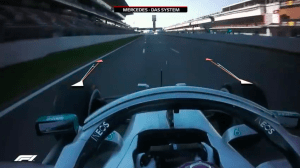F1 tech test 2020: F1 DAS system
The technical innovation of Mercedes F1: DAS system.
Presentations, dreams, hopes; then we go to the track for the first test in Montmelò and Mercedes immediately scares everyone. Not only or not so much for the times at the time trial but above all for having displaced everyone with yet another technical innovation that promises problems. For opponents.
The DAS sytem introduction is at the technical level, an innovation that will be remembered for the future decades such was the DRS (How DRS works?) in the recent past.
The technical novelty that is impressing the world of Formula 1 is the so-called DAS (Dual Axis Steering), the mobile steering introduced by Mercedes on Thursday, immediately attracting both the attention of the competition from the Brackley team and the insiders.
Many obvious engineering tricks and innovations of the past get banned right away, as teams around the paddock complain and moan to FIA officials. In this case, the FIA has deemed Mercedes’ DAS system legal for the 2020 F1 season but illegal from 2021 and onward, according to Motorsport.


From Lewis Hamilton’s onboards, it was evident that the steering wheel was able to retract at certain moments, and then return to a neutral position.
How DAS system works: a cunning system to change toe.
Through mobile steering, Hamilton appeared able to reduce the toe angle into a straight position; a solution that would favor tire wear, tire temperature control and top speed. When activated, the word “marker” appears on the steering wheel; the system would appear to be disarmed at the touch of a button, so as to return the set-up of the W11 to standard conditions to face the rest of the track. So, when Hamilton pulls the steering wheel closer to his body, the wheels move into a straight position, but pushing back in returns them to their traditional toe-out position. That’s, in simple words, how the F1 Das system, developed by Mercedes works.
Toe-out is advantageous in the corners, because the car feels more stable on turn-in. However, the angle of the tires causes uneven heating of the tires, making the inner portion of the tread hotter than the rest of the tire. Running with the front tires upright and straight will make sure the whole tire tread heats up more evenly. Don’t you know what toe is? We’ve talked about suspension angles in our specific articles (How suspension works: TOE).


The advantages of DAS: the reaction of competitors.
If it works as intended during the season, Mercedes could see better tire wear, better heating of its tires and maybe a slight top speed advantage on the tracks with longer straightaways (also due to the better aerodynamic shape). Every other team needs to decide if they want to scramble and develop their own version of the DAS system or fight for the FIA to outlaw it. The Australian Grand Prix weekend is only three weeks away, so time is not the competition’s friend right now.
If it actually worked like this, the DAS would be particularly useful on circuits with long straights, such as Monza. It seems that it is a totally mechanical instrument, which uses the movement of the steering column to lever the wheel hub.
It is a revolutionary system, capable of creating a new dimension among the tools that can be used by the drivers to refine the balance of the car and manage the tires, one of the very few painful keys of Mercedes so far. It will take some time to understand exactly how the DAS works, but it is clear that Mercedes has made the technical hit in a season with a stable regulation compared to that of last year. The green light of the FIA is there, with all due respect to rivals, and there seems to be no reason to believe that it could harm the safety of the drivers.
Update: Ferrari team principal Mattia Binotto says it wouldn’t be able to introduce a DAS system until mid-season. “I have no idea if it would be worthwhile or not,” Binotto said, “but it’s certainly longer than that. It’s an entire concept design, producing homologation, just to be safe. So if it is, I think it can be like mid-season, not earlier.”


Share this entry